At 2 p.m. Friday on the day after Thanksgiving President Trump’s administration released an important document about our climate. Required every four years by a 1990 act of Congress, the Fourth National Climate Assessment focuses on the human welfare, societal, and environmental elements of climate change.
Surprising in its bluntness, it lays out the devastating effects on the economy, health, environment, and wildfires. Within the 1,656-page document wildfires are covered rather extensively and photos of fires are used several times in the headers of sections, like the one below for Chapter 1 (which may have been taken at the Howe Ridge Fire in Glacier National Park in Montana in August).
The scientists concluded that by the middle of this century, the annual area burned in the western United States could increase 2–6 times from the present, depending on the geographic area, ecosystem, and local climate. The area burned by lightning-ignited wildfires could increase 30 percent by 2060.
In the Southeast rising temperatures and increases in the duration and intensity of drought are expected to increase wildfire occurrence and also reduce the effectiveness of prescribed fire. Intra-annual droughts, like the one in 2016, are expected to become more frequent in the future. Thus, drought and greater fire activity are expected to continue to transform forest ecosystems in the region.
In the Southwest, recent wildfires have made California ecosystems and Southwest forests net carbon emitters (they are releasing more carbon to the atmosphere than they are storing). With continued greenhouse gas emissions, models project more wildfire across the area. Under higher emissions, fire frequency could increase 25%, and the frequency of very large fires (greater than 5,000 hectares) could triple.
The Northwest is likely to continue to warm during all seasons under all future scenarios, although the rate of warming depends on current and future emissions. The warming trend is projected to be accentuated in certain mountain areas in late winter and spring, further exacerbating snowpack loss and increasing the risk for insect infestations and wildfires. In central Idaho and eastern Oregon and Washington, vast mountain areas have already been transformed by mountain pine beetle infestations, wildfires, or both, but the western Cascades and coastal mountain ranges have less experience with these growing threats. Forests in the interior Northwest are changing rapidly because of increasing wildfire and insect and disease damage, attributed largely to a changing climate. These changes are expected to increase as temperatures increase and as summer droughts deepen.
Below are wildfire-related excerpts from the report.
Chapter 1: Overview
The impacts of climate change and extreme weather on natural and built systems are often considered from the perspective of individual sectors: how does a changing climate impact water resources, the electric grid, or the food system? None of these sectors, however, exists in isolation. The natural, built, and social systems we rely on are all interconnected, and impacts and management choices within one sector may have cascading effects on the others.
For example, wildfire trends in the western United States are influenced by rising temperatures and changing precipitation patterns, pest populations, and land management practices. As humans have moved closer to forestlands, increased fire suppression practices have reduced natural fires and led to denser vegetation, resulting in fires that are larger and more damaging when they do occur. Warmer winters have led to increased pest outbreaks and significant tree kills, with varying feedbacks on wildfire. Increased wildfire driven by climate change is projected to increase costs associated with health effects, loss of homes and other property, wildfire response, and fuel management. Failure to anticipate these interconnected impacts can lead to missed opportunities for effectively managing risks within a single sector and may actually increase risks to other sectors. Planning around wildfire risk and other risks affected by climate change entails the challenge of accounting for all of these influences and how they interact with one another.
[…]
In the western United States, increasing wildfire is damaging ranches and rangelands as well as property in cities near the wildland–urban interface. Drier conditions are projected to increase the risk of wildfires and damage to property and infrastructure, including energy production and generation assets and the power grid.
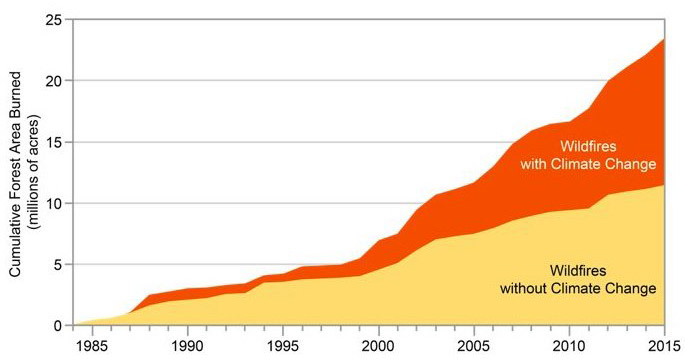
Chapter 6: Forests
Recent insect-caused mortality appears to be far outside what has been documented since Euro-American settlement and is likely related to climate change. It is unclear if the apparent climate-related increase in area burned by wildfire is outside the range of what has been observed over centuries of fire occurrence.
Case Study: Increased Wildfire Risk in the Southeastern United States
Southeastern landscapes are dominated by private lands and relatively high human populations, so changes in social behavior (for example, human-caused fire ignitions), policy (for example, fire suppression), and climate can affect wildfire activity. Modeling studies suggest that the southeastern United States will experience increased fire riskand a longer fire season. Although projections vary by state and ecoregion, on average, the annual area burned by lightning-ignited wildfire is expected to increase by at least 30% by 2060, whereas human-ignited wildfire is expected to decrease slightly due to changes in factors driving human-ignited wildfire, including projected losses of forestland and increased efforts to suppress and prevent wildfires. Although native vegetation is well-adapted to periodic wildfire, most people living near wildlands are not. More frequent and larger wildfires, combined with increasing development at the wildland–urban interface (where people live in and near forested areas), portend increasing risks to property and human life. For example, a prolonged dry period in the southern Appalachian region in 2016 resulted in widespread wildfires that caused 15 deaths and damaged or destroyed nearly 2,500 structures in Gatlinburg, Tennessee . In a warmer climate, increased fire frequency will damage local economies and degrade air quality in the Southeast.
Rapid Forest Change—Wildfire
Most fire-prone forests (forests that are likely to burn at least once every few decades) have the ability to persist as more fires occur, but the resilience of these ecosystems depends on three factors: 1) continued presence of fire-adapted species, 2) fire intensity (the amount of heat energy released) and frequency of future fires, and 3) societal responses to increased fires. A century of fire exclusion in fire-prone forest ecosystems in the United States (especially lower-elevation ponderosa pine forests and mixed conifer forests in dry locations in the West) has created landscapes of dense forests with high flammability and heavy surface and canopy fuel loads (combustible dead and live vegetation). Over the past 20 years, a warm, dry climate has increased the area burned across the Nation. Large, intense wildfires in some locations have been difficult to suppress, increasing risk to property and lives, including those of firefighters. The cost of fire suppression has also increased over time, partially driven by the high cost of protecting property in the wildland–urban interface.
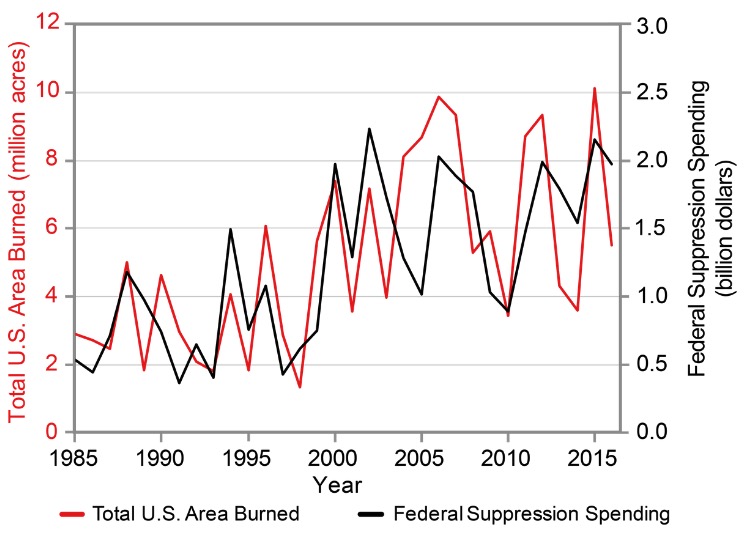
The duration of the season during which wildfires occur has increased throughout the western United States as a result of increased temperatures and earlier snowmelt.Increased vapor pressure deficit and reduced summer precipitation have deepened summer droughts in the West and thus increased wildfire risk. By the middle of this century, the annual area burned in the western United States could increase 2–6 times from the present, depending on the geographic area, ecosystem, and local climate. An increase in the area burned, however, does not necessarily translate to negative impacts to ecosystems (Figure 6.5). As the spatial extent of wildfires increases, previously burned areas will in some cases provide fuel breaks that influence the pattern, extent, and severity (the degree to which fire causes vegetation damage and mortality) of future fires. Future wildfire regimes will be determined not only by climate but also by topography, fuel accumulation (as affected by plant growth and frequency of disturbances), and efforts to suppress and prevent fires.
Wildfire risk can be reduced in low-elevation, dry conifer forests in the West and conifer forests in the South by reducing stand density (thinning), using prescribed burning, and letting some fires burn if they will not affect people. Frequent prescribed burning in fire-prone and fire-dependent (forests that require fire to maintain structure and function) southern forests has been a socially accepted practice for decades, illustrating how wildfire risk can be reduced. However, health risks from smoke produced by prescribed burning are a growing concern in the wildland–urban interface (see Ch. 19: Southeast for additional discussion about fire in the southeastern United States and Ch. 13: Air Quality, KM 2 on the effects of wildfires on health).
[…]
Wildfires can also increase forest openness by killing midstory and overstory trees, which promotes earlier snowmelt from increased solar radiation. This, in turn, leads to more winter runoff and exacerbates dry summer conditions, especially in cooler interior mountains. In warmer forests, typically in wetter climates where wildfire is currently rare, increased forest openness can in some cases increase snowpack retention. Wildfires can increase erosion and sediment in western U.S. rivers, as well as reduce tree cover adjacent to rivers and streams and thus increase stream temperature. In eastern U.S. forests, the proportion of tree species with moderate water demands (mesophytes) is increasing in many areas as a result of fire exclusion, less logging and other disturbances, and possibly a warmer climate. Mesophytes transpire more water than other species occupying the same area, thus reducing streamflow.
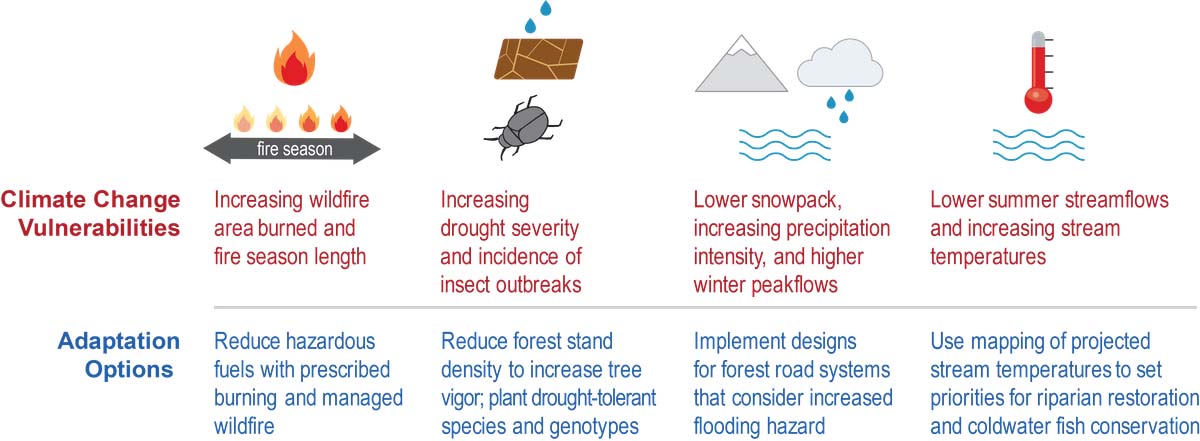
[…]
Fortunately, many ongoing practices that address existing forest management needs—stand density management, surface fuel reduction, control of invasive species, and aquatic habitat restoration—contribute to the goal of increasing resilience to higher temperatures, drought, and disturbances. Fuel treatments across large landscapes have the additional benefit of creating defensible space for fire suppression, especially near the wildland–urban interface. Resource managers are evaluating how these practices can be modified and implemented to address future climate risks. For example, forest managers in dry western U.S. forests are considering greater reductions in stand density to increase forest resistance and resilience to fire, insects, and drought. Implementation of these practices can be costly, often confront legal and administrative barriers, and must consider economic tradeoffs associated with management of other natural resources.
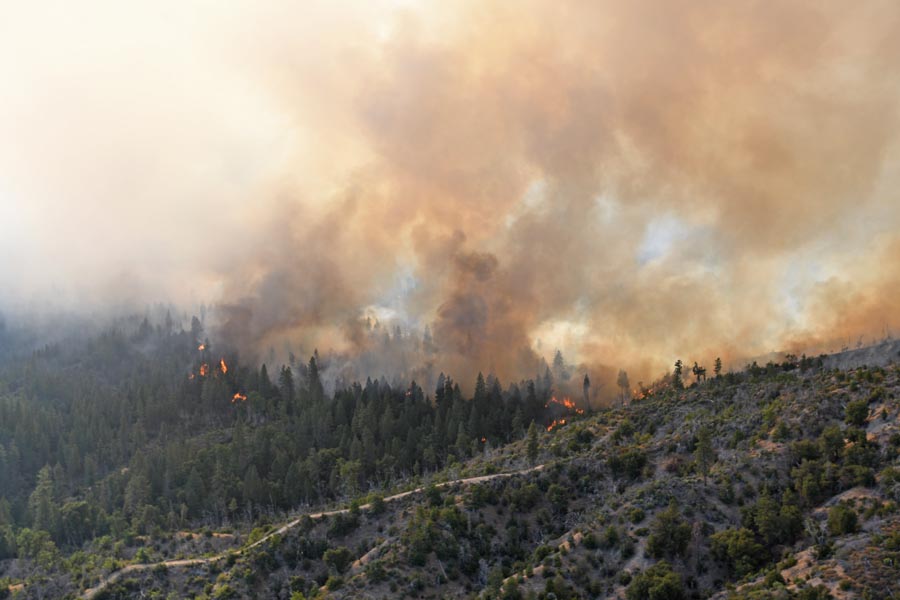
Wildfires: During the summer of 2015, over 10.1 million acres—an area larger than the entire state of Maryland—burned across the United States, surpassing 2006 for the highest annual total of U.S. acreage burned since record keeping began in 1960. These wildfire conditions were exacerbated by the preceding drought conditions in several states. The most extensive wildfires occurred in Alaska, where 5 million acres burned within the state. In Montana, wildfires burned in excess of 1 million acres. The costliest wildfires occurred in California, where more than 2,500 structures were destroyed by the Valley and Butte Fires; insured losses alone exceeded $1 billion. In October 2017, a historic firestorm damaged or destroyed more than 15,000 homes, businesses, and other structures across California (see Figure 1.5). The Tubbs, Atlas, Nuns, and Redwood Valley Fires caused a total of 44 deaths, and their combined destruction represents the costliest wildfire event on record.
Chapter 13: Air Quality
Wildfires not only emit gases that contribute to ozone formation but they also are a major source of PM, especially in the western United States during the summer and in the Southeast (see Ch. 6: Forests; Ch. 19: Southeast, Case Study “Prescribed Fire”; Ch. 24: Northwest; and Ch. 25: Southwest). Wildfire smoke can worsen air quality locally, with substantial public health impacts in regions with large populations near heavily forested areas. Exposure to wildfire smoke increases the incidence of respiratory illnesses, including asthma, chronic obstructive pulmonary disease, bronchitis, and pneumonia. Smoke can decrease visibility and can be transported hundreds of miles downwind, often crossing national boundaries.
Climate change is expected to impact atmospheric PM concentrations in numerous ways. Changing weather patterns, including increased stagnation, altered frequency of weather fronts, more frequent heavy rain events, changing emissions from vegetation and human sources, and increased evaporation of some aerosol components will all affect PM concentrations. In addition, more frequent and longer droughts would lengthen the wildfire season and result in larger wildfires and increased dust emissions in some areas.
[…]
Wildfire smoke degrades air quality, increasing the health risks to tens of millions of people in the United States. More frequent and severe wildfires due to climate change would further diminish air quality, increase incidences of respiratory illness from exposure to wildfire smoke, impair visibility, and disrupt outdoor recreational activities.
Climatic changes, including warmer springs, longer summer dry seasons, and drier soils and vegetation, have already lengthened the wildfire season (see Ch. 6: Forests) and increased the frequency of large wildfires. Human-caused climate change is estimated to have doubled the area of forest burned in the western United States from 1984 to 2015.99Projections indicate that the wildfire frequency and burned area in North America will continue to increase over the 21st century due to climate change.
Wildfires and prescribed fires contribute to ozone formation and are major sources of PM, together comprising about 40% of directly emitted PM2.5 in the United States in 2011. Exposure to wildfire smoke increases the risk of respiratory disease and mortality. Longer fire seasons and increases in the number of large fires would impair both human health108 and visibility. Wildfires are projected to become the principal driver of summertime PM2.5 concentrations, offsetting even large reductions in emissions of PM2.5precursors.
Opportunities for outdoor recreational activities are also vulnerable to changes in the frequency and intensity of wildfires due to climate change. Climate change-induced increases in wildfire smoke events are likely to reduce the amount and quality of time spent in outdoor activities (see Ch. 22: N. Great Plains, KM 3 and Ch. 24: Northwest, KM 4). More accurate forecasting of smoke events may mitigate some of the negative effects through changes in timing of outdoor activities.
Forests are actively managed, and the frequency and severity of wildfire occurrence in the future will not be determined solely by climate factors. Humans affect fire activity in many ways, including increasing ignitions and conducting controlled burns and fire suppression.110,111 Forest management decisions may outweigh the impacts of climate change on both forest ecosystems and air quality.
[…]
Chapter 19: Southeast
In the Southeast region, changing fire regimes (defined by factors including frequency, intensity, size, pattern, season, and severity) are expected to have a large impact on natural systems. Fire has historically played an important role in the region, and ecological diversity in many southeastern natural systems is dependent upon fire. Although the total area burned by wildfire is greatest in the western United States, the Southeast has the largest area burned by prescribed fire and the highest number of wildfires. In the future, rising temperatures and increases in the duration and intensity of drought are expected to increase wildfire occurrence and also reduce the effectiveness of prescribed fire. Moreover, rapid urban expansion near managed forests has the potential to reduce opportunities to use prescribed fire, which could lead to native species declines, increased wildfire occurrence, and economic and health impacts.
A recent example of the importance of fire lies in the forests of the southern Appalachians. Over the last century, invasive insects, logging, and pathogens have transformed forests in the region. Warmer temperatures and insects have led to the loss of cold-adapted boreal communities, and flammable, fire-adapted tree species have been replaced by less flammable, fire-sensitive species—a process known as mesophication. However, intense fires, like those observed in 2016, can halt the mesophication process. High temperatures, increases in accumulated plant material on the forest floor, and a four-month seasonal drought in the fall of 2016 collectively produced the worst wildfires the region has seen in a century. Intra-annual droughts, like the one in 2016, are expected to become more frequent in the future. Thus, drought and greater fire activity are expected to continue to transform forest ecosystems in the region.
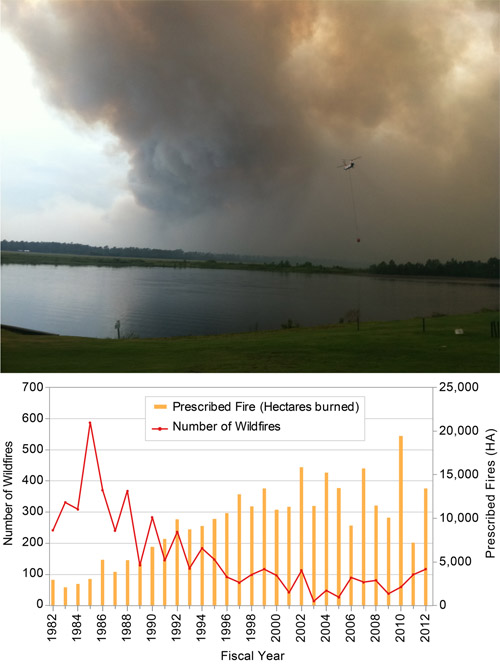
[…]
The Southeast is one of the most dynamic regions for forest change on the globe, though much of the change owes to intensive rotations of pine production and economic forces that drive frequent conversion between forest and agricultural uses in rural areas. Climate is expected to have an impact on the region’s forests primarily through changes in moisture regimes. Species migration westward across the eastern United States in response to changing precipitation patterns has already been noted. Drought is likely to alter fire regimes and further interact with species distributions (see Key Message 3). The interactions of altered precipitation and natural disturbances will be important in understanding impacts to the forests not dominated by industrial forestry (Ch. 6: Forests, KM 1 and KM 3).
Wildfire is a well-known risk in the Southeast region, where it occurs with greater frequency than any other U.S. region. However, mitigation strategies, particularly the use of prescribed fire, can significantly reduce wildfire risk and have been widely adopted across rural communities in the Southeast. A doubling of prescribed fire at the landscape scale has been found to reduce wildfire ignitions by a factor of four, while it is well documented that prescribed fire reduces the potential for crown fire in treated forest stands. With greater projected fire risks, more attention on how to foster fire-adapted communities offers opportunities for risk reduction.
From Chapter 25: Southwest
Climate change has driven the wildfire increase, particularly by drying forests and making them more susceptible to burning. Specifically, increased temperatures have intensified drought in California, contributed to drought in the Colorado River Basin, reduced snowpack, and caused spring-like temperatures to occur earlier in the year. In addition, historical fire suppression policies have caused unnatural accumulations of understory trees and coarse woody debris in many lower-elevation forest types, fueling more intense and extensive wildfires.
Wildfire can threaten people and homes, particularly as building expands in fire-prone areas. Wildfires around Los Angeles from 1990 to 2009 caused $3.1 billion in damages (unadjusted for inflation). Respiratory illnesses and life disruptions from the Station Fire north of Los Angeles in 2009 cost an estimated $84 per person per day (in 2009 dollars). In addition, wildfires degraded drinking water upstream of Albuquerque with sediment, acidity, and nitrates and in Fort Collins, Colorado, with sediment and precursors of cancer-causing trihalomethane, necessitating a multi-month switch to alternative municipal water supplies.
Ecosystems can naturally slow climate change by storing carbon, but recent wildfires have made California ecosystems and Southwest forests net carbon emitters (they are releasing more carbon to the atmosphere than they are storing). Wildfire has also exacerbated the spread of invasive plant species and damaged habitat. For example, repeated wildfire in sagebrush in Nevada and Utah has caused extensive invasions of cheatgrass, reducing habitat for the endangered sage-grouse.
Post-wildfire erosion damages ecosystems by denuding hillsides, such as occurred in Valles Caldera National Preserve in New Mexico when the 2011 Las Conchas Fire generated the biggest local erosion event in 1,000 years. In New Mexico, consecutive large wildfires degraded habitat and reduced abundance of six out of seven native cold water fishes and some native insects, although nonnative fishes were less affected. With continued greenhouse gas emissions, models project more wildfire across the Southwest region. Under higher emissions (SRES A2) (see the ScenarioProducts section of App. 3), fire frequency could increase 25%, and the frequency of very large fires (greater than 5,000 hectares) could triple. The Santa Ana winds and other very dry seasonal winds increase fire risk in California and Mexico. Under higher emissions (SRES A2), sediment flows after fires would double in one-third of western U.S. watersheds modeled, with the sediment potentially damaging ecosystems, homes, roads, and rail lines (Ch. 12: Transportation; Ch. 17: Complex Systems). Under the higher scenario (RCP8.5), cumulative firefighting costs for the Southwest could total $13 billion from 2006 to 2099 (in 2015 dollars, discounted at 3%).
Reducing greenhouse gas emissions can reduce ecological vulnerabilities to wildfire. For example, under a higher emissions scenario (SRES A2), climate change could triple burned area (in a 30-year period) in the Sierra Nevada by 2100, while under a lower emissions scenario (SRES B1174 ), fire would only slightly increase.
Allowing naturally ignited fires to burn in wilderness and preemptively setting low-severity prescribed burns in areas of unnatural fuel accumulations can reduce the risk of high-severity fires under climate change. These actions can naturally reduce or slow climate change because long-term storage of carbon in large trees can outweigh short-term emissions. Proactive use of fire in Yosemite, Sequoia, and Kings Canyon National Parks has improved the resilience of giant sequoias and other trees to severe fires and protected their stores of carbon.
Climate change has also contributed to increased forest pest infestations, another major cause of tree death in Southwest forests and woodlands (Ch. 17: Complex Systems, Box 17.4). Bark beetle infestations killed 7% of western U.S. forest area from 1979 to 2012, driven by winter warming due to climate change and by drought.


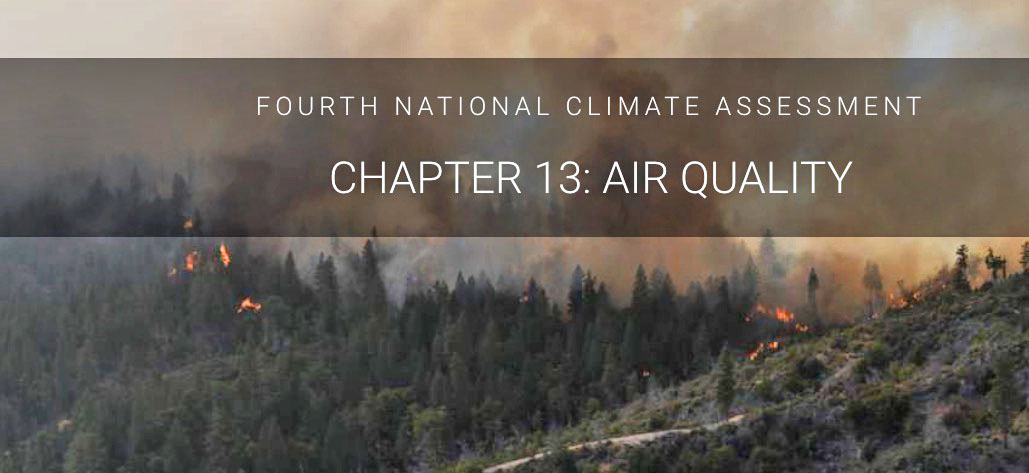
The increasing numbers and size and severity of wild fires, as well as the forecasts made by this climate assessment are the indicators needed to call for a top-down and bottom-up reevaluation of all wildland management and wildfire response practices, from permitting housing development in fire prone areas, to initial and prolonged fire fighting measures as well.
The status quo is not working and obviously is going to be far less effective in the future. Everything has to be on the table, including raising the priority of initial and sustained fire fighting response on a national level, and breaking the long standing belief that urban sprawl into fire prone areas is somehow a good thing.
The above article is very informative and all should read this ,and re -read.
The scenarios presented are of significant concern ;and are not palatable .
Another important question[s] is : How are we preparing for Wildfires that may be 2 -6 X worse ,in the coming years . Unfortunately , preparedness seems to be lagging far behind the threats of these disasters .
We need more thoughtful answers on this ,or an admixture of answers ;and more equipment and trained Wildland Firefighters!\
Please no winging any answers ;just well thought out ideas, that are acceptable TO ALL GROUPS !~!
Will any western US forests still exist mid-century?